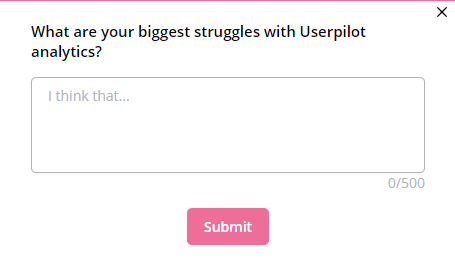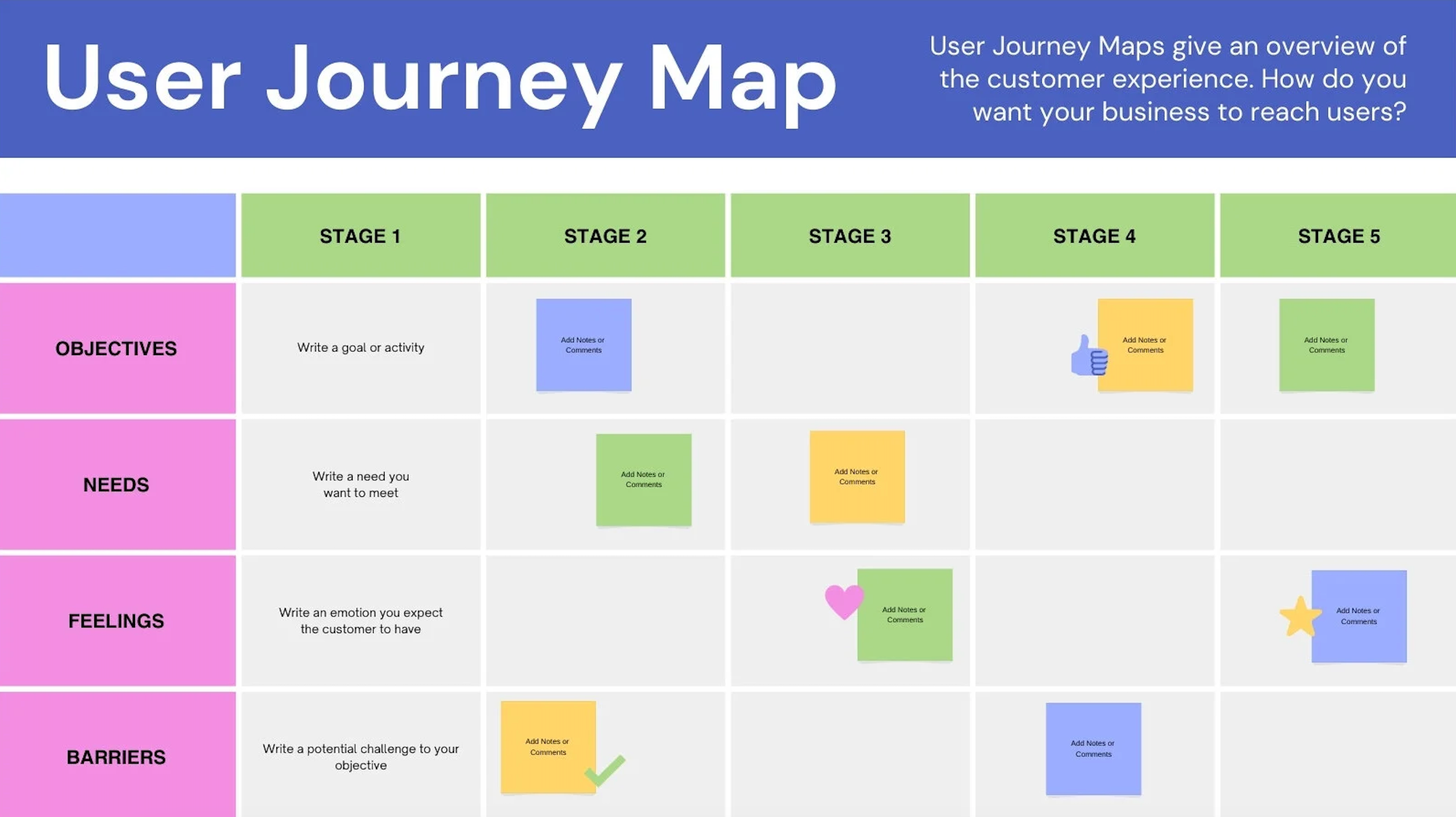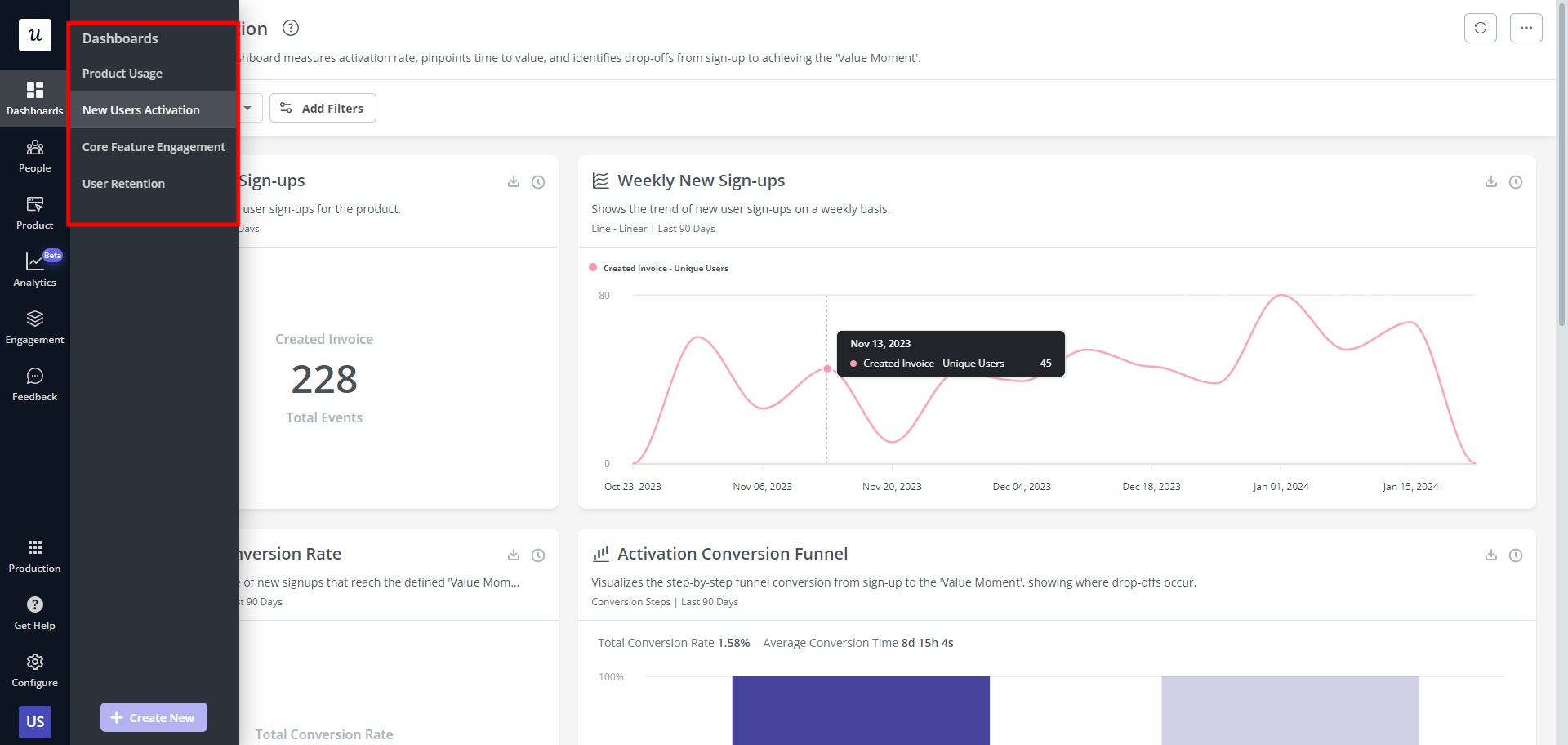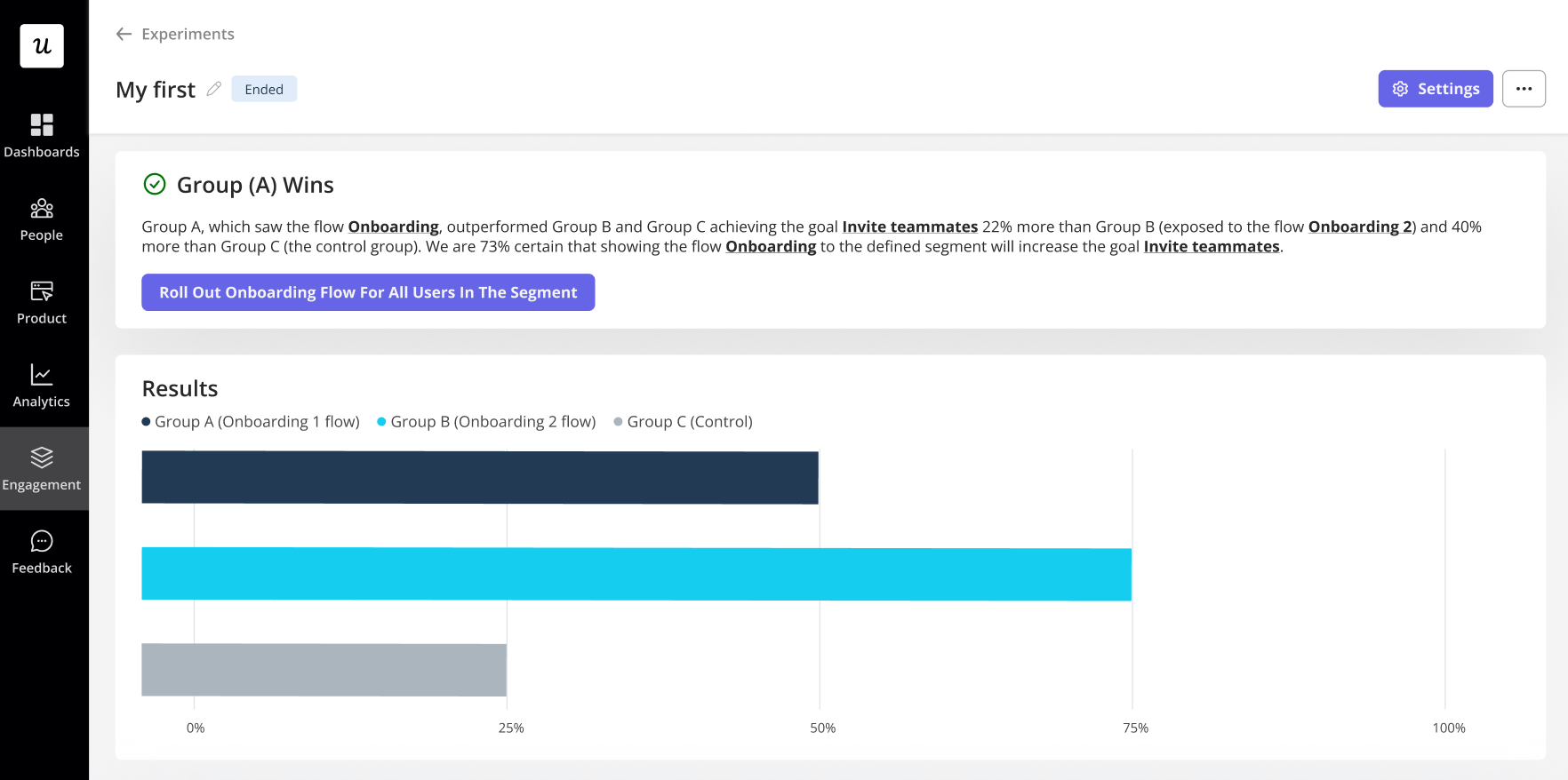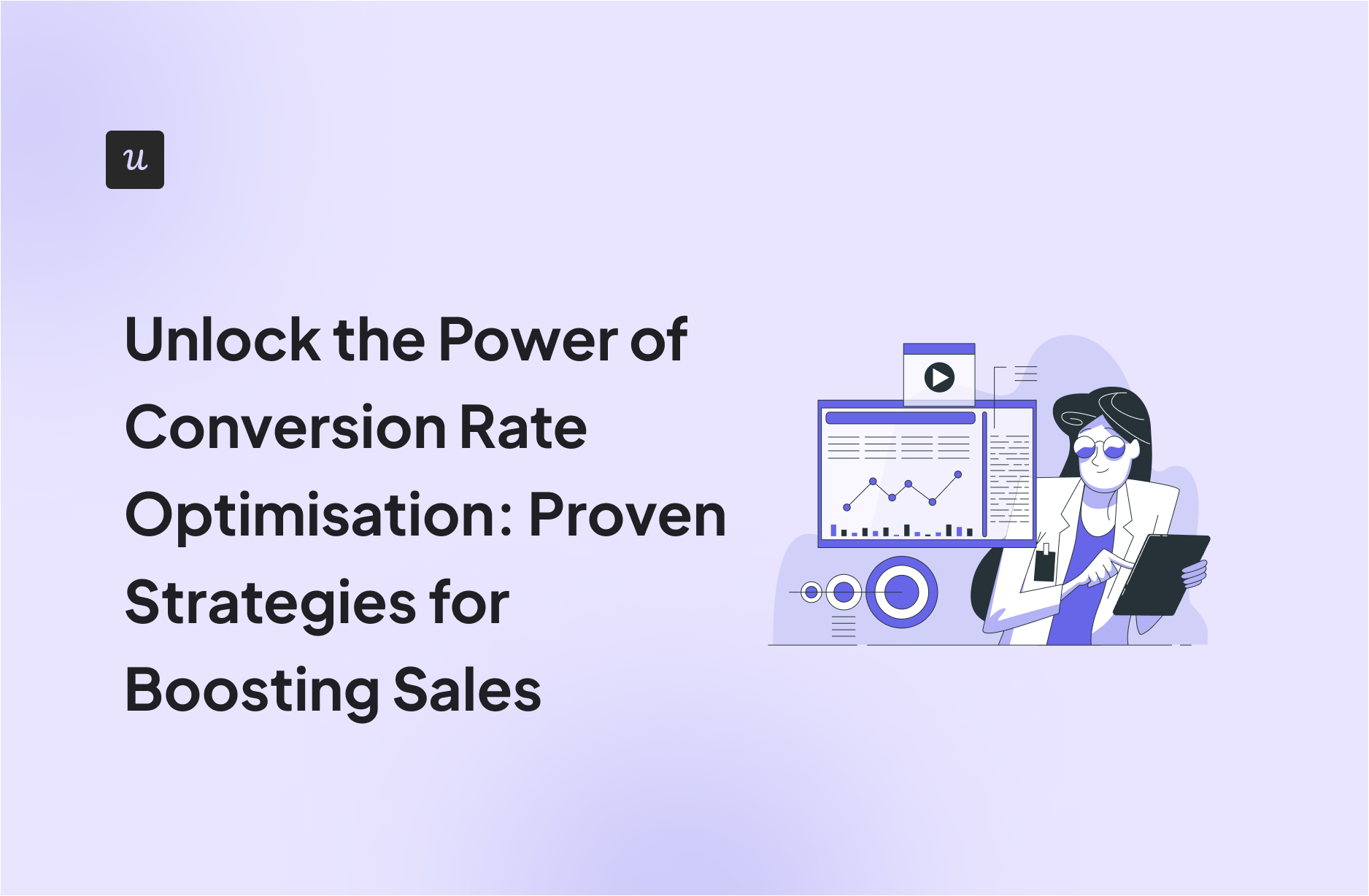
Unlock the Power of Conversion Rate Optimisation: Proven Strategies for Boosting Sales
Try Userpilot Now
See Why 1,000+ Teams Choose Userpilot

What is conversion rate optimization?
Conversion Rate Optimization (CRO) is a key part of online marketing that turns website visitors into customers.
It’s all about understanding what customers want and tweaking your website to encourage them to take action, like buying a product or signing up for a newsletter. CRO is important because it helps businesses improve their online operations, cut costs, and make their sales processes more efficient. The steps involved in CRO are important for reaching these goals.
But what makes it incredibly powerful is the potential to:
- Double the number of leads and customers with a relatively small improvement in conversion rates.
- Boost your average conversion rate.
- Ramp up customer acquisition.
- Enhance your website performance.
CRO is your key to unlocking these possibilities.
Why is conversion rate optimization important for SaaS companies?
For software as a service (SaaS) businesses, conversion rate optimization (CRO) is far more than mere industry jargon—it serves as an essential tool for sustainable revenue enhancement and bolstering the overall value of the company. Even slight upticks in conversion rates can have significant implications on revenue streams, positioning CRO as a potent arsenal in the SaaS sector’s toolkit. It aims to enhance the customer experience to increase conversions, thereby optimizing marketing investments both in terms of performance and finances.
Beyond simply increasing user acquisitions and minimizing attrition rates, CRO methodologies within SaaS entities strive to better user interactions by eliminating barriers that may disrupt their experience. This commitment not only heightens client satisfaction but also improves public perception of your brand. Conversion rate optimization leverages data derived from testing various components along the customer path—helpful information that pinpoints profitable market segments and advertising conduits for refined fiscal allocation towards marketing endeavors.
There’s an intrinsic partnership between search engine optimization (SEO) and CRO strategies which amplifies organic reach while simultaneously fostering a smooth journey for users navigating your platform—a synergy conducive to elevating customer conversion levels significantly.
Crafting a user-centric CRO strategy
Developing a user-focused strategy for conversion rate optimization (CRO) starts with in-depth knowledge of your audience. By dissecting what they require, you can gain valuable perspective on the driving forces behind their behaviors, which is critical to improving conversion rates. Comprehending these needs is merely one component. The other essential factor lies in enhancing site functionality (like increasing page loading speed) as this also has significant implications for conversion rates.
To ensure an effective CRO approach, it’s vital to establish precise objectives at each segment of the conversion funnel that assists in steering users towards specific outcomes seamlessly. Pairing this with a thorough analysis of how customers navigate through your site enables the discovery and removal of any barriers hindering conversions. These combined steps constitute the core framework necessary for creating a centered strategy around CRO based on user experience. Aligning webpage content with user expectations is crucial to drive more conversions.
Identifying user needs and pain points
To guarantee that your website caters effectively to the needs of its users, you must pinpoint exactly what those needs and issues are. You can do this by engaging with customers through surveys and direct dialogues to capture a clear picture of their preferences, requirements, and difficulties they encounter.
Using surveys represents an impactful strategy for garnering instant reactions concerning user interaction with your website. They serve as illuminators regarding the rationale behind potential customers exiting before making a purchase, directing you towards facets needing refinement. So how does one boost survey completion rates? The key resides in crafting brief and uncomplicated questionnaires while emphasizing that participation takes barely any time at all.
Mapping the conversion funnel
It’s essential to comprehend the path a user takes in CRO, often depicted as a conversion funnel. This pathway follows the visitor from their entry point on your website through to when they take an action that you desire. Enhancing specific web pages crucial to this process can provide deeper insights into the funnel dynamics and highlight areas needing improvement.
Simply delineating the user journey within the conversion funnel isn’t enough. It’s also critical to break down funnel data by different dimensions such as traffic sources, devices used for access, geographic locations of users, and various patterns of user behavior. This segmentation is key in obtaining a more granular understanding of how distinct audience groups interact with your site.
It is vital to track important metrics like bounce rates and the site’s conversion rate at each stage within the funnel for evaluating its effectiveness and identifying stages where optimization might be necessary for better performance.
Enhancing web page elements for better conversions
Optimizing elements on a web page can lead to an enhanced user experience and elevate conversion rates. To boost these metrics, consider the following tactics:
- Minimize distractions on your landing page by eliminating navigation links and unrelated content to focus visitors’ attention squarely on achieving the conversion goal.
- Distribute calls-to-action throughout your web pages in various forms and places, maximizing the likelihood of a visitor engaging in conversion activities.
- Feature one clear, dominant CTA to capitalize fully on potential conversions.
Adopting strategies that emphasize above-the-fold content is another efficient approach. Ensuring users encounter crucial information without needing to scroll helps captivate them swiftly and fosters actions leading to conversions.
It’s essential to enhance your landing page’s loading times as slow speeds may deter visitors from staying, particularly detrimental for paid ads campaigns where each click counts more heavily against bounce rates and could adversely affect conversions.
Leveraging analytics for CRO success
Analytics is a powerful ally in CRO. It offers tools for tracking website performance and user behavior, ultimately guiding your optimization efforts. By setting up specific conversion goals within analytics platforms, you can measure the effectiveness of your CRO efforts. Plus, analytics platforms like Google Analytics allow users to:
- Track website performance and user behavior.
- Share goal configurations with others.
- Foster collaborative analytics work.
- Maintain data privacy.
In essence, leveraging analytics in your CRO process can make your efforts more targeted and effective. By understanding how users interact with your website, you can identify areas for improvement, formulate strategies, and measure their impact on conversion rates.
Setting up conversion goals
Establishing conversion goals within analytics tools is an essential aspect of the CRO process. By identifying and monitoring when users carry out specific desired actions, you can effectively gauge your website’s effectiveness and understand user behavior.
Designing effective A/B tests
A/B testing is a powerful method for improving your website’s conversion rate. It involves testing two versions of a webpage to see which one performs better. Designing effective A/B tests involves selecting the right variables.
When deciding which variables to test in A/B testing, you can consider the following sources for crucial insights:
- Past experiments.
- User research.
- Chat transcripts.
- Website/conversion analytics.
These sources can help you make informed decisions about which variables to include in your A/B tests.
A/B tests can be specifically tailored to test different elements across various website sections and URL structures in a controlled manner to gather actionable results. Tools like Semrush’s SplitSignal can facilitate this process. Furthermore, determining the sample size is essential in A/B testing, which can be assessed through power analysis, factoring in the desired effect size, significance level, and statistical power.
Interpreting test results
To properly interpret A/B test results, it’s essential to grasp some statistical concepts. The process of determining statistical significance encompasses several crucial actions.
- Hypothesis formulation.
- Selection of appropriate tests.
- Establishment of the alpha value.
- Computation of standard deviation.
- Utilization of t-tables for result analysis.
In A/B testing, the p-value denotes how likely it is that an outcome at least as extreme as what has been observed would occur if the null hypothesis were indeed true. Careful assessment of this measure is necessary.
Statistical power, often set around 80%, plays a vital role in A/B testing by indicating how probable it is to identify a genuine effect when one exists and thus aids in reducing Type II error occurrences. With these principles understood, you can accurately decipher your test results and make well-informed decisions regarding conversion rate optimization (CRO) techniques.
How to scale CRO across different channels
By implementing an effective strategy, you can expand CRO efforts across multiple channels to achieve greater results. This includes:
- Understanding how SEO and CRO interact and align their objectives for a synergistic plan that supports business expansion.
- Pinpointing the precise target audience utilizing insights into demographics, interests, and behaviors for targeted advertising campaigns.
- Amplifying CRO endeavors effectively through diverse advertising mediums.
To encapsulate the scaling of CRO:
- Broadening your conversion rate optimization endeavors beyond just your website’s domain.
- Deploying uniform principles and tactics over all avenues employed to draw in customers.
- Maintaining consistent messaging and execution of strategies throughout.
- Leading to enhanced conversion rates as well as augmented returns on investments.
Multi-channel CRO tactics
Employing multi-channel CRO strategies is crucial for enhancing conversion rates across various customer touchpoints. The intention is to synchronize the conversion objectives on all acquisition channels, maintaining consistent communication and strategic deployment.
Notably, several primary actions users tend to perform across these platforms may include:
- Completing a purchase transaction.
- Opting in to email communications.
- Expressing interest in product demonstrations.
- Submitting personal information via contact forms.
To excel in CRO initiatives, each channel must be tailored with content and designs that encourage these user behaviors.
Employing remarketing campaigns within paid advertising avenues helps reengage individuals who have previously shown interest in your offerings. This can lead to improved conversions.
Integrating SEO and CRO
Incorporating SEO and CRO into your digital marketing strategy is vital for its success. By optimizing content to align with the search intent of keywords, you not only draw in the correct demographic but also steer them toward taking the desired conversion steps.
Essentially, premium content should fulfill two objectives: it must add value to engage users for SEO purposes while simultaneously nudging them towards converting.
When creating calls to action, they should serve a dual function. They need to incorporate targeted keywords to enhance their SEO effectiveness as well as clearly define subsequent actions in the conversion pathway which aids in CRO efforts. Integrating these aspects guarantees that your material will be easily found by search engines and equally important, capable of propelling conversions effectively.
Utilizing advanced CRO tools and technologies
CRO is not just about strategies and tactics—it’s also about tools and technologies that enable these strategies. Advanced CRO tools have multifunctional uses that include:
- Identifying barriers.
- Enhancing user experience.
- Performing tests.
- Collecting feedback.
- Accurately measuring results to increase site traffic and conversions.
Some of these tools include:
- Landing Page Builder: Equips businesses with the ability to design, test, and deploy landing pages effectively using a user-friendly drag-and-drop interface.
- Userpilot: Focuses on behavior analytics reports and session replays.
- Plerdy: Offers funnel analysis, user experience insights, and SEO integration with tools like Semrush.
These tools provide essential capabilities for CRO (Conversion Rate Optimization).
Heatmaps and user recordings
User recordings and heatmaps are essential for gaining insight into how visitors engage with your landing page. These behavior analytics tools, by tracking user activities, enhance your ability to fine-tune the website’s effectiveness. Tools like Hotjar provide a clear visual representation of where users interact on a webpage, which is crucial in informing optimization tactics such as A/B testing and multivariate experiments.
Hotjar specifically presents an array of heatmap categories that include:
- Move maps.
- Click maps.
- Scroll maps.
- Engagement zone maps.
- Rage click maps.
Through these heatmaps, you can discern patterns in user behavior—identifying where they click most frequently, areas that capture their attention for extended periods, or points at which interest wanes—which aids significantly in refining both the aesthetic appeal and functionality of your landing page. Insights from Hotjar’s heatmap data, alongside recordings, play an integral role in uncovering obstacles deterring potential customers from completing conversions on your website.
Multivariate testing platforms
Platforms such as Optimizely and SplitSignal provide advanced tools for performing intricate A/B testing as well as multivariate tests, all with the aim of enhancing user experiences and boosting conversion rates. These platforms boast user-friendly interfaces that enable installation in mere minutes through a straightforward JavaScript snippet, eliminating the need for developer support.
Both Optimizely and SplitSignal deliver robust capabilities for executing comprehensive A/B tests and multivariate experiments. By leveraging these sophisticated testing options, you can refine your website’s functionality effectively and substantially elevate your conversions.
Conclusion
Conversion Rate Optimization (CRO) is a powerful process that can significantly improve your business outcomes. By understanding what users want and optimizing your website accordingly, setting clear goals, analyzing data, and using advanced CRO tools, you can increase the number of customers and boost your revenue.
CRO is crucial for any business looking to improve their online performance, especially for SaaS companies aiming to reduce costs and improve user experience. Embracing CRO can lead to immediate sales growth.
Frequently asked questions
What is conversion rate optimization (CRO)?
Improving user experience and understanding the needs of website visitors are key aims of Conversion Rate Optimization (CRO), a digital marketing strategy focused on enhancing conversion rates by turning visitors into customers.
Why is CRO important for SaaS companies?
For SaaS firms, CRO holds significance as it is associated with sustained revenue expansion, a boost in company worth, diminished customer acquisition costs, and improvements in the user experience.
How can I craft a user-centric CRO strategy?
For an effective CRO strategy centered around users, it is vital to collect user data, comprehend the customer journey, and fine-tune web pages to enhance conversion efficiency. By doing so, you can customize your approach to better meet the needs and actions of your users.
How can I scale CRO across different channels?
For enhancing conversion rates and achieving greater success, it’s essential to synchronize CRO (Conversion Rate Optimization) objectives with SEO strategies, focus on reaching the appropriate audience, and execute tactics across multiple channels when scaling up CRO efforts.
What are some advanced CRO tools and technologies I can use?
Employing cutting-edge CRO tools like Userpilot, Hotjar, Plerdy, Optimizely, and SplitSignal can help pinpoint obstacles that hinder user experience. These tools facilitate experimentation, enable the gathering of user feedback, and allow for precise results measurement to optimize performance.
By integrating these instruments into your conversion rate optimization (CRO) tactics, you’re likely to see a significant uplift in conversion rates.

